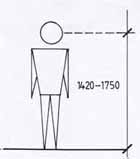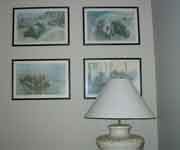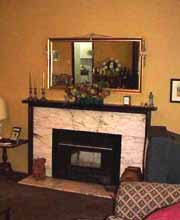Arranging Artwork in the Home
The positioning of artwork in a room can provide balance and interest if placed correctly. A mismatch of paintings haphazardly placed can be distressing to the eye and creates a sense of disorder and disjoints the flow through a room. Therefore careful consideration needs to be used when arranging artwork.
Guidelines for Arranging Artwork
Work out what you want to put where around the room and lay them out
on the floor.
Position all the artwork in the room before you start to hang it.
Position the painting on the wall so that the center of the painting is at your eye line. (approx 1420-1750mm). This will also depend on the scale of the room, the further back you are from the wall the easier it is to view without looking up or down.
If positioning a group of paintings as a feature together then the middle painting/s which will be the focus should be at eye height with the others as the surrounding decoration (even though they may be viewed closely individually we are aranging the artwork as a type of wall decoration).
If you have multiple pictures of varying sizes and you wish to group them in a space, center them around a cross formation with the larger pictures to the bottom and the smaller above, this creates a good balance for the eye as it appears that the larger pictures form the base for the smaller pictures.

Center the painting to your eyeline.

If you have multiple pictures of varying sizes and a long large wall and you want to run two rows of paintings, create a bottom and top line. Line all the top of the selected half of the paintings along the top line and the base of the remainder along the bottom line. Ensure that the left and right hand sides are square.
If you have one large picture and some small pictures of the same size that you wish to group together, place the large one in the center, the divide that in half and place centrally the next pictures along the center line. Then place symmetrically above and below that with the remainder of the pictures.
As above but the smaller pictures are differing sizes. Place the largest in the center, then find the centerline and place the second largest to one side centrally, the others can then be place on the other side lining up with the
top and bottom of the painting on the opposite side.

If you have pictures of the same size that you wish to group, they work better in a rectangle or square shape, ensuring that the spaces in between are equal and that they are exactly level all the way around. This essentially groups the work together to act as one piece.
If you want to create a formal look, but have odd sized pictures with not a hope of symmetry, set up a square and place the largest paintings in each corner to create the space, then arrange the remaining in the middle filling in the gaps.
(This may take a little time to get it right, as discussed before, arrange on the floor first).
Never place artwork over a fireplace, the heat will damage the frame
as well as the art inside, opt for a mirror instead.
If you want to create a focal point with your artwork in a room, keep it simple, don’t fill the space with things to distract you from the main piece, highlight it with lighting and give it the space it deserves.
Arrange the furniture so you are not looking at the TV but your piece of artwork instead, this create a great conversation starter and you will appreciate the work of the artist.
A small tip to keep you pictures straight and even is to place a small blob of “blue tack” on the bottom corners of the painting’s frame. These can then stick (temporarily) to the wall and keep the painting level.
If you want to have three or four similar sized painting on a wall together, line the base of them up and have equal spacings between them.
Written by Lee Brown
